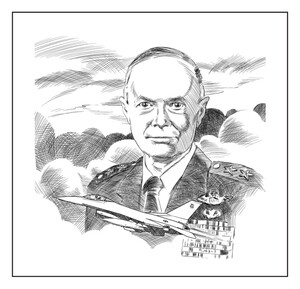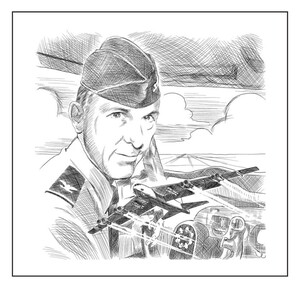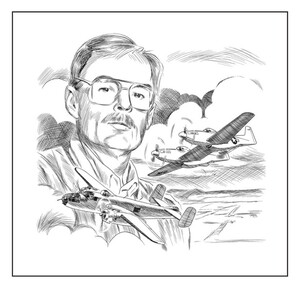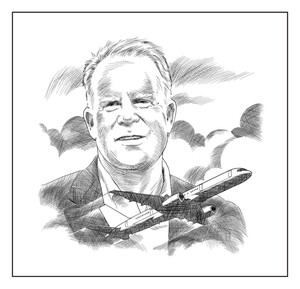2023 GAAHOF Inductees
Meet the 2023 GAAHOF Inductees
Major General George B. Harrison, USAF (Ret.)

George Harrison is a Principal Research Engineer (Emeritus), Georgia Tech Research Institute. He has overseen cross-lab activities comprising sponsored research in aerospace, transportation, electronic systems, sensors, electronic combat, signature technology, information technology, and electro-optical applications and supervised GTRI's field activities at eight locations across the United States. He moved to Georgia Tech upon his retirement from the U.S. air Force in July 1997. His initial position at GTRI was Director, Electronic Systems Laboratory, responsible for development, design, simulation, testing and fielding advanced electronic warfare systems, as well as development and implementation of test range systems and methods and later became Director, Research Operations. Additionally, as a member of the USAF Scientific Advisory Board, he brought his expertise to bear on numerous complex Air Force issues ranging from JSR integration to strike planning and execution problems with particular emphasis on directed energy, remotely piloted aircraft and human systems integration issues. He has authored numerous papers and book chapters on Directed Energy, Electronic Warfare, Human Systems Integration and Remotely Piloted Aircraft.
From 1993 until 1997, as the Commander, Air Force Operational Test and Evaluation Center, Kirtland Air Force Base, New Mexico, General Harrison brought his operational experience to bear on more than 300 Air Force systems in the acquisition process. These systems included the B-IB, B-2A, F-22, F-15E, CV-22, Joint Primary Aircraft Training System, Joint Strike Fighter, Cheyenne Mountain Upgrade Program, Minuteman III Guidance Upgrade, Joint Surveillance Target Attack Radar System, Airborne Warning and Control System Radar Staged Improvement Program and numerous other systems. In addition, he initiated and implemented a comprehensive, Air Force wide approach to the development of electronic warfare techniques. By integrating the results of live flight test and digital modeling, the entire electronic warfare process was significantly enhanced.
From 1992 - 1993, he was Commander, USAF Air Warfare Center. He conducted testing of all Air Combat Command command and control, fighter avionics and weapons. In addition to planning tests, he personally flew the aircraft involved on numerous occasions. Additionally, he directed the Air Force's command and control training school, commonly known as Blue Flag, as well as the Tactical Air Command and Control Simulation Facility. During this period, he also served on temporary assignment as joint commander of all U.S. and allied forces in Southwest Asia.
From 1991 - 1992, General Harrison was Deputy Chief of Staff for Operations, U.S. Air Forces in Europe. He directed all USAF operation in Europe, Africa and the former Soviet Union, including relief operations in all of those areas plus Bosnia. He implemented model-based planning systems to enhance efficiency in contingencies and installed modernized command and control systems to improve crisis response.
General Harrison was Assistant Chief of Staff for Studies and Analyses on the Air Staff from 1989 to 1991. He directed Air Force Studies to determine required characteristics for bomber, fighter and airlift systems through the mid 21" Century. He developed the definitive long-range plan for Air Force computer-aided analysis needs and initiated the Air Force model validation, verification and accreditation processes.
From 1962 until 1989, General Harrison served in a variety of operations and staff assignments. He commanded a tactical fighter training wing and an operational test squadron. He served as Chief, Joint Operations Division, OJCS where he was instrumental in the planning and execution of the American retaliatory raid on Libya, the capture of the Achille Lauro hijackers and numerous other contingencies. He flew 260 combat missions in the F-4 and 0-1 during the Vietnam War and 14 combat missions in the F-16C during Operation Provide Comfort in Iraq. Awards for his service include two Distinguished Service Medals, two Legions of Merit, the Distinguished Flying Cross and twelve Air Medals. Other awards include the Air Force Decoration for Exceptional Civilian Service, the Association of Old Crows Gold medal for Electronic Warfare, the USAF Glen Kent Award for leadership in Air Force analysis, and the Wright Brothers Master Pilot Award.
While serving in the U.S. Air Force and at Georgia Tech Research Institute, George has been active in a variety of civic, charitable and community service activities. While in the Air Force, he served the Boy Scouts of America as District Chairman, Rhineland Palatinate, Boy Scouts of America, Council Commissioner, Trans-Atlantic Council, BSA, and Chairman, BSA Executive Board, Southwest Region, BSA. He was Chairman, New Mexico Combined Federal Campaign, and was the U.S. Delegate to the Aerospace Applications Study Committee, NATO Advisory Group on Aerospace Research and Development, and was the Air Force Sponsor, Military Operations Research Society. He is a founding member of the Board, Air Warrior Courage Foundation, providing financial and other assistance to fallen military aviators and their survivors. He currently serves as President of that foundation.
In general aviation activity, George has been extensively involved in volunteer and youth activities. As a Patrol volunteer, he served as a Check Pilot Examiner in powered aircraft and gliders. As a glider pilot he has introduced over !000 young men and women to aviation through orientation flights. As an instructor in fifteen CAP glider summer programs, he has soloed numerous young men and women who have continued in aviation to become military and commercial pilots. As a Commemorative Air Force instructor and check pilot, he has trained many aviators in tailwheel Warbird aircraft.
A prostate cancer survivor, George has provided counselling and practical advice to dozens of other men afflicted with this feared disease. Also, as veteran dedicated to serving his fellow veterans, George has advised and counseled dozens of veterans from sergeants and chief petty officers to four-star flag officers about VA benefits and procedures, resulting in many awards of compensation and benefits to deserving veterans.
George Harrison has operational experience in the F-4, 0-1, F-16, EC-135, E-8C, and AT-38B. He is an active civil aviator with an Airline Transport Pilot license and instructor certification in single and multi-engine aircraft and gliders. He has flown 103 different aircraft types for 9300 hours including 530 hours of combat flying.
To watch the induction video of Maj. General George B. Harrison, please CLICK HERE.
Colonel Jack Henderson Powell

Colonel Jack Henderson Powell, born June 21, 1933, experienced aviation at the age of 17 when a local friend of the family took him for a ride in a Piper Cub in Gordy, Georgia. He was hooked and knew immediately that flying was his destiny. He is a native of Worth County, Georgia and resides in the area today.
He obtained degrees from Abraham Baldwin Agricultural College, the University of Omaha, Western New England University, and the United States Air Force Air War College. He holds a Master of Business Administration degree and bachelor's degree in finance.
In 1953 he joined the Air Force to become a pilot and fight in the Korean War. After initial and advanced training, he earned the positions of aircraft commander of the KC-97, B-47, KC-135, B-52, T-39, and F-105. He also served as Chief of Stan-board for the 8th Air Force. He served as the Senior Emergency Actions Officer at the National Military Command Center in the Pentagon and ending his Air Force career as the Deputy Commander of Operations of the 19th Bomb Wing at Robins Air Force Base. He was also nominated for Commander of the 89th Wing at Andrew's Air Force Base for Air Force One but elected to return to Southwest Georgia to serve his home area. During his Air Force career, he was an integral player in the Arc Light bombing campaign in Southeast Asia during the Vietnam War flying more than 300 missions in the B-52. He retired at the rank of Full Colonel.
After returning to Albany, Georgia where he originally settled during the Cuban Missile Crisis at Turner Air Force Base, he was recruited to manage Gray Air Service, a small, fixed base operation at the Albany, Georgia regional airport where he grew it tenfold. He added aircraft sales, training, leasing, charter, and pilot labor services. He attracted and secured a regional United Parcel facility at the airport creating dozens of new jobs and careers. More than twenty young pilots were groomed by him to advance from hopefuls to major airline captains and military officers.
He served on the initial Board of Directors of the Museum of Aviation and assisted in getting it off the ground. He served on the Georgia Aviation Trade Association and was President of the Southwest Georgia Regional Development Center.
To watch the induction video of Colonel Jack Henderson Powell, please CLICK HERE.
Tom Reilly

Tom Reilly was born 25 April 1942 in Philadelphia, Pennsylvania and raised in Pompton Lakes, New Jersey. In 1965 he was riding his motorcycle in Orlando, Florida and noticed a sign on an FBO, "Learn how to fly $234." He had $236 in his wallet, went in and said, "teach me how to fly." Sixteen days later, flying a 150 Cessna, he had his private ticket.
In 1971, Tom was working restoring old homes and on weekends was a skydiving instructor at the Kissimmee, Florida airport. While packing a parachute, a P51 Mustang pulled up to the hangar. Not knowing that anything like that even existed, he said, "can I have a ride." A one hour ride later, for fuel only, $32.10, his life was changed forever.
The next day he commented to a friend about the P51 ride and was told about four fixed gear T6's/Yales in Canada that were for sale. Tom immediately drove to Canada and purchased them, sold three and kept and restored the fourth, to learn how to fly a taildragger. That was the start of his Warbird career.
Slowly working his way up to larger warbirds, he took a job helping to get a P38 airworthy. During that job in Pennsylvania, he took a weekend day trip to visit his parents in New Jersey. By chance he stopped by Caldwell Wright airport and discovered an abandoned B25 Mitchell. Tom acquired it by paying off all the lien holders and over a year period had it ready for a ferry flight to its new owners in south Florida.
From there his knowledge of WWII B25's and heavy iron expanded. He purchased two more B25's to restore, and a third for an owner in Daytona Beach, which led to him getting his pilot's type rating in the B25.
Another big break came along when he was contracted to go to Moses Lake, WA to do a pre-buy on a B25 fire bomber and fly it back to Kissimmee. This led to a restoration contract on a B24 Liberator, B17 Flying Fortresses and most of an F4u Corsair.
In 1985 he moved his Warbird restoration facility to Kissimmee, Florida and opened an FBO. Being a tourist area, the opening of a Warbird Museum/Flying Tigers Warbird Restoration Museum as part of the restoration facility was a natural.
The business expanded to include an event venue, yearly warbird air show, restoration school, Waco and T6s rides. This attracted people worldwide and brought other business to the airport, thereby establishing the Kissimmee airport as a warbird tourist attraction, which it still is today.
There Tom brought up about 10 young men, taught them the warbird restoration business and signed them off for their FAA Airframe and Power Plant license. He also supported the EAA Young Eagles flying program.
As the years went by a total of nine B25's, two B17's, one B24, six T6 Texans and a multitude of other warbirds were brought back to flying condition. After 20 years in Kissimmee, the devastating hurricane Charlie and two more within a month came along and totally destroyed his facility and many display aircraft. This series of events prompted Tom to donate his museum artifacts to other museums and move what was left to Douglas, Georgia and restart his Warbird restoration business.
After settling in Douglas, Tom joined forces with Don Brooks to complete to flying condition his PT17 Stearman, P40 Flying Tiger and another B17 Flying Fortress. He purchased another B25 Mitchell to resell and collected another PSl Mustang to restore. Then came the project of a lifetime, an extremely rare restoration of the North American XP82 Twin Mustang escort fighter.
Over an 11-year, 209,000 hour man and woman restoration project, the XP82 first flew on 31 December 2018. Tom went on to win the coveted title of Grand Champion Warbird at the 2019 Lakeland Florida Sun and Fun Airshow plus a Golden Wrench, Phoenix and Grand Champion Award at 2019 Air-Venture in Oshkosh. Air-Classics Magazine called it the "Restoration of the Century."
With the XP82 complete, Tom has most recently taken on the jobs of restoring two more B17s and another B25 Mitchell bomber.
In Georgia, Tom has hired both experienced A&P employees and young men just out of high school to concentrate on teaching them the art of restoring WWII aircraft and help them work towards their FAA Certification and Airframe and Power plant license.
These Warbirds and his restoration facility have helped put Douglas, Georgia on the map for years to come.
Tom Aviation History:
- Single and multi-engine land and sea ratings
- Type ratings in B17, B25 and C47 aircraft
- Owns and flies his own B-25 Mitchell
- 5500+ total hours, most in warbirds
- 2600 hours+ in B25's
- He has instructed 23 pilots thru their B25 type ratings
- FAA Airframe and Power Plant rating with an Inspection Authorization
- The complete restoration of over 30 vintage warbirds
- 48 years now in the Warbird restoration business without a maintenance related accident
Tom's passion for preserving our nation's aviation heritage, teaching a new generation the dying art of warbird restoration and acting as a "Goodwill Ambassador" for general aviation continues.
To watch the induction video of Tom Reilly, please CLICK HERE.
Gil West

Gil is currently the Chief Operating Officer for Cruise, an autonomous vehicle company owned by General Motors, Honda, SoftBank, T-Rowe Price, Microsoft and Walmart. Responsible for the overall commercialization and operation of autonomous vehicle business. Responsible for RideShare Business Unit, Delivery Business Unit, Commercial Strategy, Data and Analytics, Project Management, Customer Service, Market Operations, Central Operations and Engineering, New Markets and Infrastructure, Risk Management and Corporate Communications and Marketing. Serve as Accountable Executive for Cruise's Safety Management System-accountable for safety. Deployed fully driverless public rideshare operations in San Francisco and was the first company to acquire the necessary permitting to accomplish this. Deployed driverless delivery pilot with Walmart in Phoenix. Developed, manufactured and currently certifying the first purpose built Level 4 autonomous vehicle ever certified by the NHTSA.
For almost 12 years, Gil formerly held the position of Chief Operating Officer and Sr. Executive Vice President, Chair Delta Holdings responsible for Delta's worldwide operations at 366 airports in 66 countries, 1,300 aircraft, 2M operations/year, 200M customers/year, 70,000+ Delta and 22,000 subsidiary employees. Responsibilities included Airport Customer Services & Operations, In-flight Services (Flight Attendants and Catering), Flight Operations (Pilots), TechOps (Maintenance & Engineering), Operations Control Center, Operations Analytics & Performance, Supply Chain Management, Fleet (aircraft strategy & acquisition), Corporate Safety Security & Compliance, Regional Operations, Cargo and Information Technology.
Led ancillary businesses of -$6B revenues including Delta Private Jets, Endeavor Airlines, Delta Connection, Delta Material Services, Delta MRO, Delta Flight Products, Delta Global Services and Cargo. Lead venture capital investments/start up activity.
Drove innovation through strategic technology investments of $900M annually.
Achieved industry leading customer service (5X increase in NPS), operational performance (moved from #7 to # I in DOT rankings) and profitability (from bankruptcy emergence to $6B pretax). International equity investments/joint ventures/alliances in Europe, Latin/Central America and Pacific region.
Successfully led merger integration with Northwest Airlines.
Achieved record earnings for the industry with EPS growth of 15%+ YOY with 2"d best performing stock in S&P 500.Achieved 25%+ ROIC, $8B operating cash flow and $SB free cash flow used to strengthen balance sheet through debt reduction, return cash to shareholders and reinvest in business. Increased unit revenue premium verses industry (120%domestic, 110% system) through differentiation of industry leading operational performance, customer service and product segmentation.
Top line growth driven by disciplined capacity growth plus pricing improvements. Non-fuel unit cost held to less than half of GDP growth rate.
Merged Delta Private Jets with Wheels Up and Delta Global Services with UNIFI.
Founded Delta Flight Products and Delta Material Services.
Awards
- Fortune's Magazine (multi-year winner) Airline of the Year
- Fortune's Most Admired Companies (#31)
- Air Transport World Airline of the Year (first domestic winner in 10 years)
- Business Travel News (multi-year winner)
- Glassdoor and Fortune's Best Companies to Work for and Best Companies for Diversity
Board of Director
- Virgin Galactic - Space tourism company with spaceship design and manufacturing company. Safety and Audit Committee.
- Genesis Park Acquisition Corporation - Aviation Special Purpose Acquisition Corporation. Acquired RedWire, a space engineering and manufacturing company taking it public. Led Compensation Committee.
- Forward Air - Expedited ground transportation and logistics company. Publicly traded. Governance and Compensation Committee.
- Wheels Up - Private jet company. Privately held.
- Monroe Energy - Delta's wholly owned subsidiary oil refinery located in Philadelphia, PA. Chair Operations Committee.
- American Cancer Society - Non-profit organization leading the fight against cancer. Finance Committee. Chair Revenue & Marketing Committee.
- Business Leaders of Michigan - CEOs of Michigan based companies improving Michigan's business climate.
- Schneller LLC Aviation - Rail and architectural interiors product manufacturing and service company.
- Aircraft Repair Technologies - Aircraft maintenance, repair and overhaul company and parts distribution.
Advisory Boards
LYFT Autonomous Advisory Board, AeroMexico Airlines, AirFrance/KLM Airlines, Virgin Airlines, China Eastern Airlines, LATAM Airlines, GOL Airlines, Engage (Georgia Tech University venture capital fund), North Carolina State University and Western Carolina University.
Education
- Masters Business Administration, National University, San Diego, California, 1994
- B.S. Mechanical Engineering, North Carolina State University, Raleigh, North Carolina, 1984
To watch the induction video of Gil West, please CLICK HERE.
Enshrinement Banquet and Ceremony
For information about the Enshrinement Banquet and Ceremony and to purchase sponsorships, tickets, or tables, please CLICK HERE.
